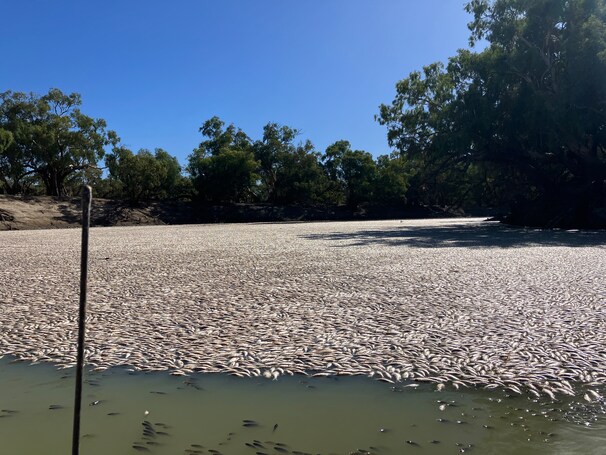Millions of dead fish are clogging up a river in southeastern Australia, angering locals who must endure the smell of rotting carcasses that have blanketed the water for days. Officials say it’s because of a lack of oxygen sparked by rising temperatures and recent floods, while residents are blaming the government for water mismanagement.
“There are dead fish everywhere,” Graeme McCrabb, a Menindee resident, said Sunday, describing the smell in the Darling-Baaka River in New South Wales as far-reaching and pungent. Among the dead fish are native species such as bony bream, Murray cod, golden perch, silver perch and carp, he said.
Video he took from his boat showed a thick carpet of silver fish carcasses on top of the water.
Australian officials have been aware of the disaster since Friday, acknowledging “a developing large-scale fish death event” involving millions of carcasses in the river. The New South Wales Department of Primary Industries (DPI) blamed low oxygen levels in the water, known as hypoxia, as floodwaters recede.
“The current hot weather in the region is also exacerbating hypoxia, as warmer water holds less oxygen than cold water, and fish have higher oxygen needs at warmer temperatures,” the agency said Friday in a statement.
McCrabb said the same remote area had recorded large-scale fish deaths in December 2018 and January 2019, calling them the result of poor-quality water entering the river, which is often used for fishing. But this time, McCrabb said, the disaster is much worse, and many in the town are “angry and disappointed” that officials appear not to have learned from the previous mass fish deaths.
“No one was ready for what was seen here,” McCrabb said, adding that officials had “failed in their duties” to manage the river and collect data to help prevent such disasters.
“If you know the quality of the water is good or bad, you can make more informed decisions on how water is released downstream from the lakes and avoid sending blackwater downstream to kill fish,” McCrabb said.
Blackwater events happen “during flooding when organic material is washed off the river bank and floodplain and into the river system,” according to the New South Wales water department.
The government said the dead fish were predominantly bony herring, a species that experiences booms and busts in its numbers.
“It ‘booms’ in population numbers during flood times and can then experience significant mortalities or ‘busts’ when flows return to more normal levels,” DPI Fisheries said. “They can also be more susceptible to environmental stresses like low oxygen levels especially during extreme conditions such as increased temperatures currently being experienced in the area.”
Cameron Lay, director of freshwater environments at DPI Fisheries, described the situation as “very distressing” and warned that temperatures of over 100 degrees in the area could bring more challenges.
“That in itself can present an ongoing risk to water quality and native fish so we will be doing everything we can to monitor the situation and use whatever management options we do at our disposal,” he said, according to the Australian Broadcasting Corp.
Accelerating climate change is warming waters and cooking creatures in their own habitats, experts say. Many species are suffocating because warmer water cannot hold as much dissolved oxygen.
A study released last year found that if greenhouse gas emissions continue to rise, roughly a third of all marine animals could vanish within 300 years.
The remote location of the recent fish deaths, in the far west of New South Wales state, is only worsening the disaster. The decaying blanket of fish has been visible for at least three days. “It’s hard to get people here in a hurry,” McCrabb said. “If you try to pick [the fish] up, you’re probably going to break them up and leave a fish soup. There’s not a lot of answers really.”
Multiple agencies are working on a response to the disaster, the New South Wales DPI said.
The water division of the NSW Department of Planning and Environment acknowledged “a large number of fish deaths” and said “dissolved oxygen levels remain a concern for fish health.”
“The reality is the Darling River is very sick. Years of mismanagement by the NSW Govt has exacerbated the impact of our changing climate,” Rose Jackson, an opposition member of the New South Wales Parliament and the shadow minister of water and housing, wrote on Twitter. The ecosystem “has been pushed to breaking point.”
On Sunday, McCrabb said fish were continuing to die in the water — adding to the already monumental loss of aquatic life. “We’ve started to lose more this afternoon,” he said, noting that some of the dead mass was beginning to move downstream.
He said more deaths along the river will be likely in the coming days: “We are in a world of hurt here.”











